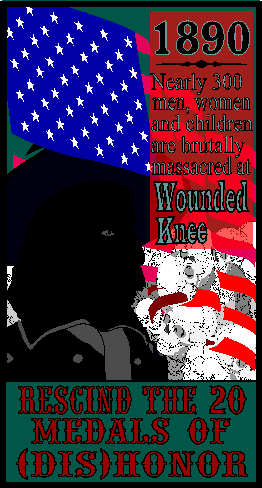

O'siyo...some thoughts on the proposal by Wasichu to attempt to make amends for Wounded Knee via a proposed Wounded Knee National Tribal Park.
On 3.9.95 Joe Quickie reposted the text of a Wasichu proposal (congressional) to the newsgroups soc.culture.native and alt.native. The proposed memorial would commemorate the "armed struggle between the Plains Indians and the U.S. Army that culminated in the death of over 300 Lakota Sioux men, women, and children at Wounded Knee, SD, on December 29, 1890." Of course, the land "would be owned by the National Park Service and "held in trust" for the Oglala and Cheyenne River nations." 1890. Not so very long ago.
Areas considered for inclusion in the park are "such sites relating to the 1890 Wounded Knee Massacre and Ghost Dance Religion, including the campsite of Chief Big Foot [Si Inskokeca] at Deep Creek, a cultural center and museum complex, the 1890 Wounded Knee Massacre site...and such other sites relating to the 1890 Wounded Knee Massacre..." Over these, interestingly, Wasichu dictates that the "Cheyenne River Sioux Tribe shall have no jurisdiction or authority..."
I have spent much time ashore in Israel. Germany, as part of it's amends program, provides Mercedes Benzs to Israel at manufacturers cost. What should Wasichu provide the First Nations/First Peoples? Land, memorials, words or, perhaps, reparation for the desecration on Mount Rushmore?
Much has been written about the Wounded Knee Massacre. But, perhaps, for those not familiar with this "military action," this final, formal extinguishment, we should turn to the words of one, American Horse, who survived the massacre:
"They turned their guns, Hotchkiss guns [breech-loading cannons that fired an explosive shell], etc., upon the women who were in the lodges standing there under a flag of truce, and of course as soon as they were fired upon they fled...There was a woman with an infant in her arms who was killed as she almost touched the flag of truce [which flew over the Lakota camp], and the woman and children of course were strewn all along the circular village until they were dispatched. Right near the flag of truce a mother was shot down with her infant; the child not knowing that its mother was dead was still nursing, and that especially was a very sad sight. The women as they were fleeing with their babes were killed together, shot right through, and the women who were very heavy with child were also killed...After most all of them had been killed a cry was made that all those who were not killed or wounded should come forth and they would be safe. Little boys who were not wounded came out of their places of refuge, and as soon as they came in sight a number of soldiers surrounded them and butchered them there...Of course it would have been all right if only the men had been killed; we would feel almost grateful for it. But the fact of the killing of the women, and more especially the killing of the young boys and girls who are to go to make up the future strength of the Indian people, is the saddest part of the whole affair and we feel it very sorely." [James Mooney, "The Ghost Dance Religion and the Sioux Outbreak of 1890," in Fourteenth Annual Report of the United States Bureau of Ethnology (Washington, D.C.: U.S. Government Printing Office, 1896) Part Two, p. 877]
"No one knows how many Indians were killed on this miserable field, because by the time anyone could count the bodies, some had already been removed. But the number was very close to three hundred, about two thirds of them women and children...Women and children attempted to escape by running up a dry ravine, but were pursued and slaughtered - there is no other word - by hundreds of maddened soldiers, while shells from the Hotchkiss guns, which had been moved to permit them to sweep the ravine, continued to burst among them. The line of bodies was afterward found to extend for more than two miles from the camp - and they were all women and children. A few survivors actually found shelter in brushy gullies here and there, and their pursuers had scouts call out that women and children could come out of their hiding places because they had nothing to fear...some small boys crept out and were surrounded by soldiers who butchered them." [Agents of Repression, The FBI's Secret Wars Against the Black Panther Party and the American Indian Movement, Ward Churchill and Jim Vander Wall, South End Press, ISBN 0-89608-294-6]20 medals of dis-Honor were awarded to soldiers of the 7th calvalry for their valiant efforts in defense of the great American way.
Can one apologize for such activity? Can one ever really say, "I am sorry," "I was wrong," "Forgive me," "Please, please forgive us." Can the pain, the blood, the shrieks, the rips, tears, sadistic barbarity, the weeping, the inhumanity and blood shed ever be compensated for? In any way shape or form?
While I am not Lakota, I respectfully suggest that the Lakota need no Wasichu memorial. Need no underlining from this country's colonizers. Need no involvement now from those who continue to persecute the First Nations/First Peoples on every imaginable level.
Justice fled from Wounded Knee more than 105 years ago. Wasichu can not run from his past and he has no right to attempt this memorial. If he wishes to make a point, then he should start by voiding those Medals of dis-Honor and begging for a forgiveness that should never be given.
Wounded Knee Home Page
First Nations Cumulative Site Index